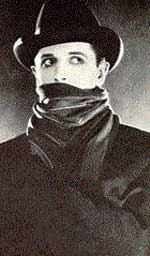 The Lodger: A Story of the London Fog (1927) regards the mysterious Jonathan Drew, played by Ivor Novello, who has an almost alien beauty on the screen, akin to that of Valentino, thus a prefect face for a silent film. The Lodger: A Story of the London Fog (1927) regards the mysterious Jonathan Drew, played by Ivor Novello, who has an almost alien beauty on the screen, akin to that of Valentino, thus a prefect face for a silent film.
He rents the upstairs rooms of a small boarding house, during a time in London when a serial killer is after women of the streets. The killer has claimed seven lives on seven successive Tuesdays. The famous 1912 novel by Marie Belloc Lowndes provided the first fictional resolution to the Jack the Ripper case, though this film calls him only "the Avenger."
When the lodger first appears at the door, he has a scarf around half his face & an eerie gaze, an obvious weirdo. So soon the landlady (Marie Ault) begins to suspect him of being the Avenger.
Daisy Bunting (played by a minor one-name actress "June") is "a daughter of the house" who works as a clothing model. Detective Joe Chandler (Malcolmn Keen) is her aggressive suitor.
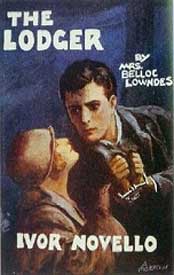 The new lodger begins to fall for Daisy & she's in turn attracted to his sensitivity & his odd elegance. By contrast, she's getting creeped out by pushy, horny Joe, who as much from jealousy as police skill decides the Lodger must indeed be the Avenger. The new lodger begins to fall for Daisy & she's in turn attracted to his sensitivity & his odd elegance. By contrast, she's getting creeped out by pushy, horny Joe, who as much from jealousy as police skill decides the Lodger must indeed be the Avenger.
As a film of Alfred Hitchock one expects even this early in his career a little something extra, as Hitch delighted in visual treats, & we do get pacing & lighting & a level of realism lacking in the average silent film. One of the more unusual FX to imply sound is when Jonathan Drew is pacing his room. The people down stairs gaze at the ceiling, which becomes momentarily transparent so we can see the souls of the lodger's shoes.
When Joe finds the lodger's map tracking the murders, & a collection of clippings about the Avenger's victims, it looks all the more certain Joe's on the track of the killer. But trusting Daisy keeps faith in Jonathan Drew even when he's cuffed & taken away.
[SPOILER ALERT] Making a daring escape from custody, Drew wanders the streets trying to hide the fact that he's still handcuffed. It's Tuesday & he has no time to waste at Scotland Yard, for he must complete his own efforts to track down the killer, as this same Avenger he believes to have been the murderer of Jonathan Drew's beloved sister.
There's a pathetical sequence in a pub when Drew attempts to get refreshment. When finally the actual Avenger is arrested, a mob has already begun to move against the innocent lodger, in a pathetical climax wherein Hitchcock for the first time works out on the screen a theme that would be common throughout his filmmaking life, that of mistaken identity & miscast blame. [END SPOILER ALERT]
It's not a great film but it's a good silent film with the Hitchcock brand of suspense already evident, plus Novello is fascinating to watch on the screen. Certainly a must-see for Hitchcock fans & for all silent film fans, with at least a possibility of grabbing the interest of less focused film buffs.
Usually regarded as a sound remake of Alfred Hitchcock's silent The Lodger, the script for The Phantom Fiend (aka, The Lodger, 1932) is in reality pretty much it's own story. As silent films tended to be more scenarios (& Hitch had used hardly any dialogue cards) the act of turning the silent film scenario into a talking picture script provided ample opportunity for improvement in the storyline & especially in the climax, though the film is much shorter than Hitchock's.
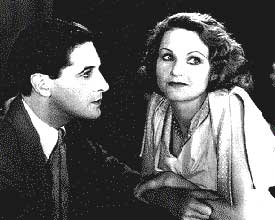 Ivor Novello reprises his role as the mysterious lodger, here named Angeloff, & good as he was in Hitchock's silent, he is just so much better this time out. He is a beautiful wild-eyed surprisingly sexy eccentric, reminiscent of Kafka, with a Bela Ligosi accent (Novello was actually Welsh so the cool accent is an affectation). Angeloff is a skillful violinist & pianist & seemingly the ideal lodger. Ivor Novello reprises his role as the mysterious lodger, here named Angeloff, & good as he was in Hitchock's silent, he is just so much better this time out. He is a beautiful wild-eyed surprisingly sexy eccentric, reminiscent of Kafka, with a Bela Ligosi accent (Novello was actually Welsh so the cool accent is an affectation). Angeloff is a skillful violinist & pianist & seemingly the ideal lodger.
The cinematography is in some ways primitive but has a rough penache. A newspaper reporter, Jack Martin (Jack Hawkins), is looking for clues to the identity of the maniac killer known as "the phantom fiend." He is also courting Daisy (Elizabeth Allen). Curiously, Daisy is a better more credible character in the silent version. In the talkie, she is excessively flirtatious to the point of being puppy-like. Her occupation is more innocuous, too, since she works at a telephone operators board instead of as a model.
The murders in the streets of London take place off screen, so there's nothing of horror in this treatment of Mrs. Lowndes' famous novel. Nor are the characters, other than the lodger himself, interesting enough to greatly care about. Yet Novello so commands the screen with his fay oddness that there's never a dull moment while he's present.
Daisy remains convinced that Angeloff is innocent even as the rest of the cast becomes suspicious that he's the phantom fiend. In the climax the poor guy is slinking around hiding from Scotland Yard, trying to hide his handcuffs. A scene in which he tries to have a beer without use of his hands is truly pitiful, & gets him the attention of the tavern's patrons. In the silent version, Daisy is with the lodger & helps him drink a brandy, but this new ending has many improvements including the pathos of Angeloff's fearful loneliness.
[SPOILER ALERT] Daisy is in the streets searching for Angeloff when she encounters the actual psycho. It is suddenly quite clear that sensitive & odd Angeloff is innocent. The killer is Stefan, Angeloff's insane brother, & with his handcuffed arms Angeloff has no choice but to strangle his brother to save Daisy, for the saddest possible of happy endings. [END SPOILER ALERT]
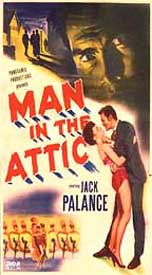 Man in the Attic (1953) has amazingly beautiful outdoor sets for the London streets. Jack the Ripper is abroad & the drunken old harlot Katy is slain in a glum, foggy alley. It was expected, & there were bobbies everywhere, but once again the Ripper escapes. Man in the Attic (1953) has amazingly beautiful outdoor sets for the London streets. Jack the Ripper is abroad & the drunken old harlot Katy is slain in a glum, foggy alley. It was expected, & there were bobbies everywhere, but once again the Ripper escapes.
Though by no means a musical, the film incorporates three musical numbers, one written by the director, two by Eliot Daniel, whose jaunty musicality is well known to everyone who has ever found themselves humming the opening themsong to I Love Lucy. These are sung by the rather innocent Mary, who becomes another of the Ripper's victims, killed in her apartment.
Aunt Bee from the Andy Griffith Show is the landlady Helen (Frances Bavier) who rents the attick room to the mysterious, gaunt & sinister Slade (Jack Palance giving a pretty darned good performance). He claims to be a pathologist who must be let alone to do his experiments. But slowly the landlady begins to suspect Slade is the Ripper.
Lily (Constance Smith) is an actress who lives in the same bording house. She rather likes Slade who despite his oddness is a good pianist & has a tragic appeal. A scene set in the Black Museum at Scotland Yard adds a strong moment of "local color" & gives the character of Slade a chance to show his neuroses.
Slade is unquestionably a neurotic but there's a sweetness about him. He falls very much in love with Lily, but he deplores her stage career, & does seem to have "issues" about "bad" women. He becomes convinced that Lily is to be his salvation & not until she fails to live up to his over-idealization does he reveal his dark aspect.
[END SPOILER ALERT] Scotland Yard gets onto Slade & discovers that the Ripper's very first victim was Slade's own mother. When his crimes are revealed, he flees through the foggy streets in a stolen horse-drawn cab. The chase through the gorgeously lit expressionist sets provides the climax, culminating with the Ripper's possible drowning at the Thames, though who can be sure since his body was never recovered. [END SPOILER ALERT]
copyright © by Paghat the Ratgirl
|
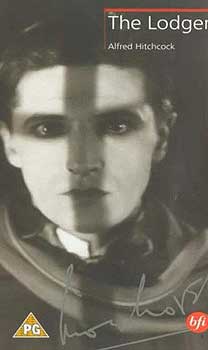

 The new lodger begins to fall for Daisy & she's in turn attracted to his sensitivity & his odd elegance. By contrast, she's getting creeped out by pushy, horny Joe, who as much from jealousy as police skill decides the Lodger must indeed be the Avenger.
The new lodger begins to fall for Daisy & she's in turn attracted to his sensitivity & his odd elegance. By contrast, she's getting creeped out by pushy, horny Joe, who as much from jealousy as police skill decides the Lodger must indeed be the Avenger. Ivor Novello reprises his role as the mysterious lodger, here named Angeloff, & good as he was in Hitchock's silent, he is just so much better this time out. He is a beautiful wild-eyed surprisingly sexy eccentric, reminiscent of Kafka, with a Bela Ligosi accent (Novello was actually Welsh so the cool accent is an affectation). Angeloff is a skillful violinist & pianist & seemingly the ideal lodger.
Ivor Novello reprises his role as the mysterious lodger, here named Angeloff, & good as he was in Hitchock's silent, he is just so much better this time out. He is a beautiful wild-eyed surprisingly sexy eccentric, reminiscent of Kafka, with a Bela Ligosi accent (Novello was actually Welsh so the cool accent is an affectation). Angeloff is a skillful violinist & pianist & seemingly the ideal lodger.